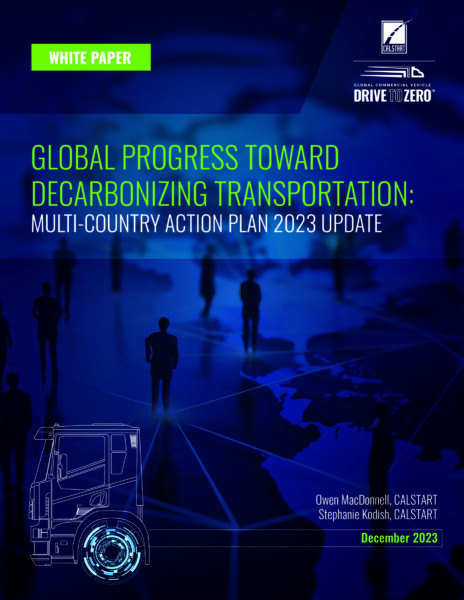Throughout 2023 I reflected on transportation within the broader context of the climate movement and the ways in which this massive, ongoing, long-term existential threat can seem a Sisyphean challenge, out of our control where climate success appears hostage to the whims of the political and economic structures we inhabit. And yet, transportation feels different—a sphere where our exertions could evince change (to push the metaphor—as if Sisyphus had an electric truck to help with that boulder!).
We have all seen trucks spewing black smoke, and we have all experienced the pungent smell of diesel fuel or gasoline exhaust in the air. While we know transportation is essential, the filthy externalities that we associate with it do not need to be eternal.
With an urgency building around clean transportation, 2024 appears as a pivotal year on the path to carbon neutrality and beyond.
Building on the victories of 2023, 6 additional nations pledged to cut greenhouse gas emissions from transportation by signing the Global MOU on Zero-Emission Medium- and Heavy-Duty Vehicles. Now 33 national governments have established a target of 100% new sales of zero-emission medium- and heavy-duty vehicles by 2040—these nations represent 1 in every 5 new commercial vehicles across the globe, a significant market signal.
This is a critical time and luckily, we work together with all Global MOU nations to devise, advance, and report on policy developments, successes, and zero-emission practices to provide insights and examples for any country or region looking to improve their air quality and climate. From our work with these trailblazers, I can share the following 5 actions, which have emerged as top priorities for the coming year to stay on track to achieve 30% new sales of ZE-MHDVs by 2030, 100% by 2040, and full carbon neutrality by 2050.
Strong Requirements: Once a country commits to Global MOU goals, the necessary first step is for states to stand up an aligned regulatory framework that reduces commercial vehicle GHGs and results in ZE-MHDV production and use. This foundational action is the most important, as it informs and aligns stakeholders, timelines, and benchmarks. In 2023 the European Union proposed new limits on greenhouse gas emissions from MHDVs. Calling for a 90% reduction in CO2 from trucks by 2040 and 100% reduction in CO2 from buses in 2035, this proposal, which must pass one more vote of approval, will provide significant momentum to the European ZE-MHDV market and will fortify stakeholders, like fleets and manufacturers, with the confidence to invest with certainty in these clean technologies.
Supporting Policies: Regulations are a vital aspect of supercharging the ZE-MHDV market, but they must be paired with a robust array of supportive policy actions that create an ecosystem to accelerate the market. Financial mechanisms such as direct subsidies or exemptions from certain taxes or road fees can sway fleets big and small as they assess the total cost of ownership of ZE-MHDVs. Regulators, with the support of industry experts, must design and implement the policies and strategies needed to de-risk investment in vehicles and infrastructure, reform electric grid operations to enable faster charging, and identify priority geographies for early deployments. These actions will in turn create the next generation of best practices, tools, and policy instruments that further entrench market certainty.
Public & Private Investment: Increased capital from governments and private investors is fundamental to scaling the transition globally. Investments in vehicle production alongside zero-emission recharging and refueling infrastructure development must align with the energy and vehicle needs to meet regulatory milestones and timelines. Many countries are seeing a disproportionate mismatch between private (and public) capital that funds the fossil fuel industry, and production of fuels traditionally used in transportation, versus the efforts underway and capital required to decarbonize this sector. Public funds should be prioritized to leverage increased investment from the private sector and investor community to achieve the greatest and most rapid impact per dollar. Building on these investments, we have seen profitable business models and use cases emerge around the world thanks to major efficiency improvements between powertrains and cost savings through the operation of the vehicle.
Transport/Electric Grid Integration: Political leadership is needed to delegate clear governance structures that turn the urgency for change into synchronized, systems level actions with harmonized timelines for decarbonization. While energy production is being decarbonized at a faster rate than transportation, these two sectors are often moving separately and independently of one another. Energy, utility, and transport agencies and stakeholders need to prioritize infrastructure planning, forecast demand, and make targeted co-investments and deployments in the highest priority areas. The critical integration of transport with clean energy—specifically with the electricity grid—needs to become a pillar of country infrastructure planning and requirements. Ensuring grid operators are well integrated into the planning and execution of policy decisions in such a way that additional capacity can be forecast and added to the grid to reduce friction between implementation goals and the capability of existing infrastructure.
Equity: Any successful zero-emission transition must embed the equitable transition for fleets of all sizes in country policy, as well as in the siting of national charging networks for commercial vehicles. Recognizing and centering the diverse needs of fleets around the world through intentional program and policy design is essential to ensuring a clean transportation future, directly reducing the impact of pollution on frontline communities.
The key to a successful transition, healthy communities, and a sustainable planet is unprecedented collaboration across borders and industries, unlocked by firm national policy and driven by innovative changemakers big and small.
